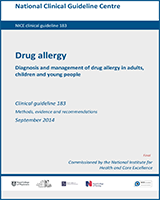Drug Allergy
NICE Clinical Guidelines, No. 183
Authors
National Clinical Guideline Centre (UK).Excerpt
All drugs have the potential to cause side effects, also known as ‘adverse drug reactions’, but not all of these are allergic in nature. Other reactions are idiosyncratic, pseudo-allergic or caused by drug intolerance. The British Society for Allergy and Clinical Immunology (BSACI) defines drug allergy as an adverse drug reaction with an established immunological mechanism. The mechanism at presentation may not be apparent from the clinical history and it cannot always be established whether a drug reaction is allergic or non-allergic without investigation. Therefore, this guideline has defined drug allergy as any reaction caused by a drug with clinical features compatible with an immunological mechanism.
Hospital Episode Statistics from 1996 to 2000 reported that drug allergies and adverse drug reactions accounted for approximately 62,000 hospital admissions in England each year. There is also evidence that these reactions are increasing: between 1998 and 2005 serious adverse drug reactions rose 2.6-fold.116 Up to 15% of inpatients have their hospital stay prolonged as a result of an adverse drug reaction.
About half a million people admitted to NHS hospitals each year have a diagnostic ‘label’ of drug allergy, with the most common being penicillin allergy. About 10% of the general population claim to have a penicillin allergy; this has often been because of a skin rash that occurred during a course of penicillin in childhood. Fewer than 10% of people who think they are allergic to penicillin are truly allergic. Therefore, penicillin allergy can potentially be excluded in 9% of the population.
Studies have shown that those with a label of penicillin allergy are more likely to be treated with broad-spectrum antibiotics, such as quinolones, vancomycin, and third-generation cephalosporins (Lee, 2000). Use of broad-spectrum antibiotics is associated with an increased rate of clinical complications, such as antibiotic resistance and Clostridium difficile leading to increased hospital stay (Macy,2014). Patients in intensive care who developed vancomycin-resistant enterococcus (VRE) were 5 times more likely to have been treated with vancomycin and third generation cephalosporins during the previous month (Martinez, 2003)108. Therefore, an unsubstantiated label of penicillin allergy may lead to the inappropriate use of broad spectrum, non-penicillin antibiotics leading to antibiotic resistance and in some cases sub-optimal therapy.
Allergic reactions to non-steroidal anti-inflammatory drugs (NSAIDs), such as ibuprofen, diclofenac, naproxen and aspirin are common. In particular, 5–10% of people with asthma are affected. About one-third of people with chronic urticaria have severe reactions to NSAIDs, involving angioedema and anaphylaxis after administration of NSAIDs.
Anaphylaxis-type reactions occur in approximately 1 in 1000 of the general population. Anaphylaxis during general anaesthesia occurs in between 1 in 10,000–20,000 anaesthetics. These patients may be denied general anaesthesia in the future unless a safe combination of drugs can be identified.
Major issues identified by this guideline include poor clinical documentation of drug allergy and a lack of patient information. Computerised primary care record systems are often unable to distinguish between intolerance and drug allergy and this can lead to a false label of drug allergy, particularly if the person’s reaction took place many years previously and details about their reaction have been lost. Furthermore, there is no routine system in place for people to keep a record of their own drug allergies. This can lead to confusion over which drugs can be taken safely and can result in people inadvertently taking a drug they are allergic to, particularly when buying over-the-counter preparations from a pharmacy.
Analysis of patient safety incidents reported to the National Reporting and Learning System between 2005 and 2013 identified 18,079 incidents involving drug allergy. These included 6 deaths, 19 ‘severe harms’, 4980 ‘other harms’ and 13,071 ‘near-misses’. The majority of these incidents involved a drug that was prescribed, dispensed or administered to a patient with a previously known allergy to that drug or drug class.
Diagnosing drug allergy can be challenging and there is considerable variation both in how drug allergy is managed and in geographical access to treatment. This can lead to under-diagnosis, misdiagnosis and self-diagnosis. This variation may be caused by insufficient awareness of available services or by a lack of local provision of drug allergy centres. Some people are never offered referral to specialist services and instead stay in primary care while others have their drug allergy managed in other disciplines. Therefore, only a small proportion of people are treated in specialist allergy centres.
In view of the variation in provision of care for people with drug allergy, the scope of this guideline identified a need for guidance to improve clinical management for people affected by drug allergy. Although NICE guidance would normally refer to the term ‘medicine’ rather than ‘drug’, in this instance the term ‘drug allergy’ has been adopted as this is the term widely recognised and in common usage, and reflects the focus on drug treatments rather than other preparations.
This guideline has been developed for use by healthcare professionals at all levels of healthcare and offers best practice advice on the diagnosis, documentation and communication of drug allergy in adults, children and young people.
Disclaimer: Healthcare professionals are expected to take NICE clinical guidelines fully into account when exercising their clinical judgement. However, the guidance does not override the responsibility of healthcare professionals to make decisions appropriate to the circumstances of each patient, in consultation with the patient and/or their guardian or carer.
